What is Trenchless Technology?
The Trenchless Technology is a family of methods, materials and equipment for the installation, replacement, transfer, diagnosis, location, renovation and rehabilitation of underground services with a minimum of excavation and surface interruption. The trenchless technologies have been used successfully for all underground utilities from water pipes, sewage, rainwater, gas, industrial pipelines, conduits for electrical and communications networks.
What are the reasons for adopting Trenchless Technology?
Economic:
- By means of the inspection of the networks, the detection of leaks and the faults presented by the installations are achieved: pipes, wells, manhole, sewers, household connections, which allows to establish the most efficient and least expensive intervention types.
- With the location of the networks by non-invasive means it avoids breaking the pipes of other services that are found in the execution of the works.
- Less trips of dump trucks and debris disposal because there is much less excavation in installation of new infrastructure and there is no debris in rehabilitation of existing ones.
- Reconstruction of platforms and roads at junctions.
- Signage and surface enclosures throughout the works to prevent children or inhabitants from falling into the ditches.
- Expenses for damage to existing pipes and suspension of service.
- Standby payment due to interruptions due to rain.
- Cost of security to prevent theft and robbery of criminals in work zones and communities.
- Costs of environmental permits and traffic.
- Limitation of work schedules that make the work more delayed due to noise problems that affect the community.
- Water expenditure to control the dust cloud.
- Repair of cracked houses and breaking glass in the excavation area by thrown particles.
- Damage to vehicles with ditches leaving their garages.
- Payments of garages to the inhabitants for impediment of access of the vehicles.
- Payment of damages due to community accidents in the ditches.
- Construction of complementary works to facilitate access to their homes or places of disabled people.
- Cost of non-contractual insurance for damages to third parties.
- Costs of socialization with communities and lifting of neighborhood records.
- Costs for felling trees and gardens.
- Invasion of the roads by the limitation of spaces on platforms generates the use of additional pallets and cleaners.
- Costs of debris disposal and replenishment with filling materials.
Environmental:
- Less impact on contamination by CO2 and particulate material.
- Decrease in noise.
- Reduces the affectation to flora and fauna.
- The use of quarry materials is reduced.
- Less debris is generated in new infrastructure facilities and nothing in rehabilitation.
Regulations and legislation
United Nations Organization
![]() Descargar / Download
Descargar / Download
Social:
- Less impact on the mobility of cities because they occupy minimal space on the surface.
- The access to the houses, commercial premises is not obstructed which causes discomforts and in some cases enormous losses in businesses because the route with ditches is closed.
- When there are no ditches, the safety of people is improved.
Problems of the cities that are fixed with Trenchless Technologies

DO NOT BREAK ROADS
Why don't you have to break the tracks to install a pipeline, whether it is an aqueduct, sewer, gas, energy, telephone, internet or cable television?; since the precise solution exists without making annoying or dangerous ditches, which have caused the death of workers and passers-by. In addition, they close the entrance to the garages of the houses or businesses and affect the mobility of the cities.

One of the trenchless technologies is on-site repair. This consists of fixing the pipeline by lining it inside, without needing to change it, when the damage is slight, that is, when it presents leaks or infiltrations.
Now, for pipes that are collapsed or fractured, the existing pipe is broken and simultaneously a new pipe of the same diameter, or even a larger diameter, is introduced, without digging in the track. In both situations, work is done internally where the pipe is.
This solution is more economical because the road does not have to be paved again and, in some cases, the tube does not have to be changed.
HOW TO FIND PIPES UNDER THE FLOOR WITHOUT BREAKING IT
One of the situations that we have seen or suffered when citizens are going to carry out a work or change a pipe in the streets or platforms, either with a backhoe machine or digging with a pick and shovel, is that they break the water pipe, the gas pipe or from the sewer producing a sometimes gigantic and dangerous leak. In addition, the population is left without the service. For the contractor it is an extra cost that they do not pay and a delay in the work. The utility company suffers because in the case of water, it must supply the service in tank trucks until the problem is fixed.
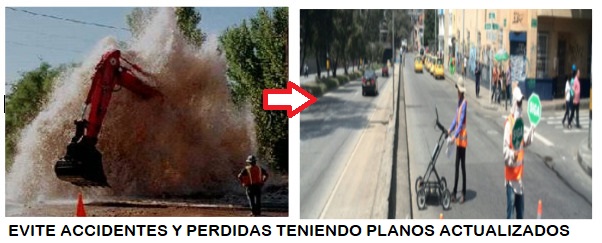
To avoid these uncomfortable and expensive situations, there is a precise solution, which consists of previously locating the pipes that are where the works are to be carried out. For this there are several technologies, but today we are going to refer to the most commonly used, which is with georadar equipment.
This technology is based on passing through the work area, a georadar equipment that has tires and is manually powered by a person, accompanied by one or two assistants, who carry antennas to transmit the signal. The georadar sends a wave through the ground and detects the presence of the aqueduct, sewer, gas, energy, telephone, internet or cable television pipes that are below the floor surface. This information is then processed to obtain a plan that contains the location, the type of public service, the material with which the tube was made, the diameter of the tube and the depth.
More sophisticated companies in Colombia use drones to take a photo of the site and incorporate it into the plan, so that it has the location of the point where the excavation will be carried out, as seen on the street.
HOW TO DETECT LEAKS AND DAMAGE IN THE PIPES
It has become common, especially in the rainy season for the streets to flood, producing unpleasant and harmful odors for the health of citizens and especially children.

We also see how the asphalt pavement collapses or the concrete pavement fractures, creating gaps in the roads into which people and cars fall, causing serious physical and material damage. Although the hole is repaired, after a short time it is again open, because the damage to the pipeline, which is causing the sinking, has not been solved.
This happens, among other things, because the pipes are working at their maximum capacity. City and municipal sewer companies must carry out inspections at least every 3 years to prevent these problems, especially where there are new buildings or when they have built a building where there was a house. Logically, the pipes are insufficient to serve the new apartments, as is happening in most cities in the country.
The precise solution with trenchless technology is to inspect the pipes with television cameras that enter the sewers. A video is made and the findings found are reported through technical reports that reflect the state they are in, such as, for example, embedded tree roots, fractures, infiltrations, leaks, separate joints, deformations, cracks, collapses, etc. The reports are final to determine the works to be carried out to rehabilitate or expand the existing pipeline, or when the installation of a new pipeline without a trench is required. These must be standardized for easy understanding and monitoring. For this, the guidelines for the evaluation of pipelines that have been implemented in the country are used, with the support of the sewer society in the United States and that are taught by ICTIS.
HOW TO REDUCE AIR POLLUTION
Urban open-air works generate dust clouds contaminating the air with particulate material that is the most dangerous for health, since it causes bronchitis, colds, asthma or cancer. Dump trucks leave trails of dirt on the tracks. Additionally, they knock down the trees that are in their path to lay the pipes and generate unbearable noises for the citizens.
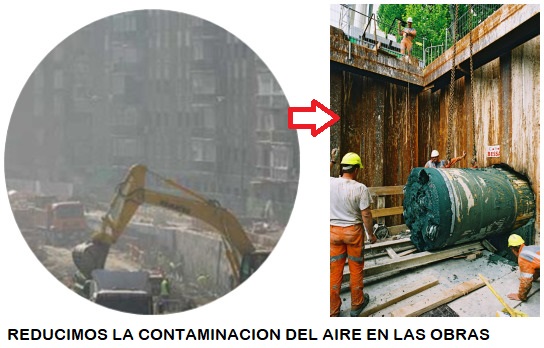
Construction technologies in the world have advanced in recent years to do the works that society requires, minimizing the environmental impact.
Trenchless technologies for utility pipeline maintenance completely prevent air pollution caused by dust suspension because no excavation is required. It's that simple, the pipes are rehabilitated or repaired inside the existing tube, either by placing a new tube, lining it or covering it with resin or concrete. In this way, its useful life is extended for another 50 years.
Now, to change the fractured pipes or to install new pipes, only a small excavation is made to introduce the equipment to be broken or excavated below the surface. They carry out the underground excavation and remove the wet material, therefore there is no resuspension of dust on the tracks when loading and transporting. Far fewer dump trips are required and thus less carbon dioxide contamination. As the works are underground, the trees do not have to be knocked down because we pass under them.
HOW TO AVOID ACCIDENTS WITH POST ELECTRIC WIRES
Transfer the overhead electricity and telephone cables, supported by light poles, to underground pipelines, in order to avoid accidents that normally have the consequence of electrocution of people and cuts in service. Also, these “cobwebs” of cables make cities look bad and in some cases they are attached to houses and buildings. In coastal cities with high levels of salinity, the contacts are constantly isolated, causing frequent blackouts.
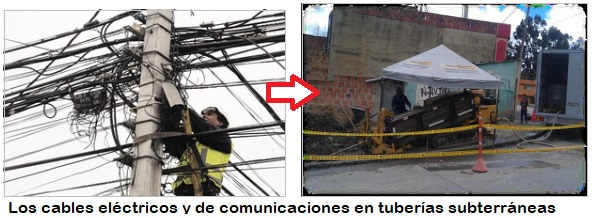
The underground installation of the pipes that will carry the cables inside is made below the tracks, causing the least impact on traffic, and below the platforms so as not to affect access to homes and businesses.
The solutions offered by the trenchless technology and defined by the project designer taking into account aspects such as the type of soil, the distance and the size of the cables, among others are:
- Horizontal directed drilling is one of the ditchless technologies used for this type of work and consists of carrying out a first excavation with a diameter smaller than that of the pipe that will remain. The excavation is then enlarged in one or more passes with larger bits. Drilling fluids are used to support the hole wall, remove excavated material, and lubricate the cutting tool. Once the diameter of the tube has been reached, the polyethylene pipe is pulled with the machine. The tube inlet and outlet boxes are made, being ready to lay the electrical, telephone, internet or cable television cables.
- Pipe ramming that uses an impact machine that digs the steel tube into the ground and then removes the material that remains inside the tube.
- The auger boring or propeller machines and the micro-boring machines dig the ground in front of the tube and simultaneously place it behind it as they go. When it reaches the end point, the machine is taken out and the pipe is ready to introduce the cables inside.
- Lately, a machine has been developed in Germany that combines a directed horizontal drilling machine with a micro-tunnel boring head. This machine reaches lengths greater than 1 kilometer in all types of geology including rock.
PIPE LEAKS INCREASE RATES AND AFFECT WATER QUALITY
In the country we have great differences between the quantity of drinking water that leaves the treatment plants versus the quantity of invoiced water. In some cities, losses reach 67%, while the average loss in the country fluctuates around 30%, which becomes an extra cost for users.
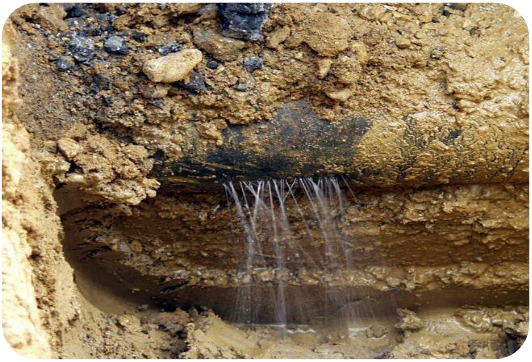
There are multiple causes for these losses, but this time we are going to refer to the losses due to leaks that are under the control of the maintenance departments of the public water utility companies. When the water pipes have porosities, fractures, gaps, cracks and faulty connections, not only do they expel the water, but in turn, microorganisms enter that affect the quality of the water.
The solutions offered by trenchless technologies make these leaks detectable even if they have not yet surfaced. There are high-precision methods and equipment for inspecting and monitoring pipelines to prevent and locate leaks. Some methods use acoustic fiber optics or a so-called intelligent ball because inside it it has electronic devices that take data on the state of the pipe as it travels inside the pipe. Other teams additionally show live video footage and pipeline mapping.
Once the leak or wear of the pipe due to aging has been located, trenchless technologies are used to repair it, replace it or install a new one in such a way that the quality of the water is preserved and the losses or major damages that end up paying are reduced. users on your invoice.
Trenchless technologies are based on improving the quality of life of the community, ensuring the quality of services and protecting public resources so that they have the efficient use that we all expect.
HOW TO AVOID BREAKING THE ROAD TO CONNECT FROM THE HOUSE OR THE BUILDING TO THE SEWER TUBING
It is common to see unpaved ditches in the streets up to the middle of the road that make them to connect to the city's sewer pipes. Attention building managers, architects, homeowners, businesses and companies we inform you that with technologies without a trench you can install the pipe and save the expense of paving the road again.
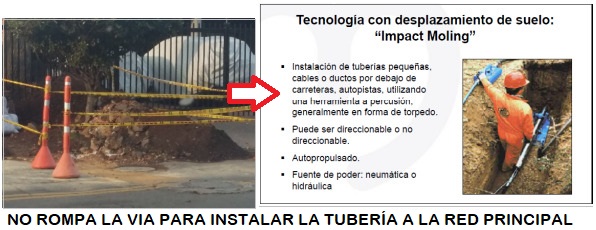
For this, impact drilling equipment, known as pneumatic moles or missiles, are used. These devices are portable and have a range of up to 15 meters in length. A small excavation is made to place the equipment and direct it towards the tube to which it will be connected (with the prior permission of the public service entities). The team penetrates the ground with blows and when the end point is reached, the polyethylene hose is pulled and the excavation where the team was located is used to make the concrete box. To correct imperfections in the tie of the two pipes, a hat-shaped fitting is installed on the new pipe and the rim is glued to the city sewer pipe.
Now, if there are leaks in the pipes outside or inside your facilities, these can be repaired internally. To do this, a camera is inserted to locate the damage or leak, and then the pipe is lined or a coating is made with an epoxy resin.
Trenchless Technologies Guide
![]() Descargar / Download
Descargar / Download






